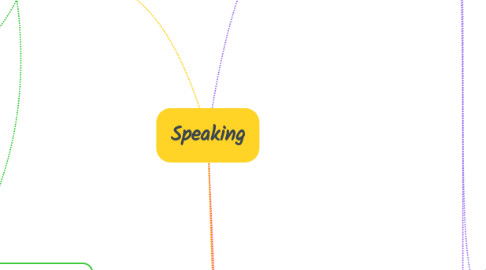
1. The first approach he calls “direct” and it consists of analyzing oral language in individual components that are taught, practiced and recombined (for example, sounds, words or fixed expressions). This approach can be equated with the bottom-up processes
2. The second approach to the development of speaking skills is labeled as “indirect” and assumes that speaking develops naturally and spontaneously through ongoing interaction. In this second approach, students are encouraged to engage in sustained communication and the teacher provides support as needed.
3. a) Transactional: aimed at exchanging informationa) Transactional: aimed at exchanging information. b) Interpersonal: aimed at promoting social relationships. c) Presentational: used when one speaker alone conveys information.
4. Managing speaking tasks
5. Various authors (Harmer, 2007; Ur, 2012; Thornbury, 2012) seem to agree that the development of speaking skills requires both a knowledge and a skills base.
6. 6 distinct classroom speaking types that teachers can promote in the classroom:
7. Speaking is generally taken as synonymous to achieving mastery in a language. When people ask us “Do you speak English?” they are actually asking, “Do you know English?” As Ur (2012, p. 117) explains “People who know a language are referred to as ‘speakers’ of the language.
8. Douglas Brown (2007) explains that a conversation generally consists of five basic moves. There is first of all a nomination of the topic of the conversation. Next, speakers strive to keep the conversation going by actively responding to what the other is saying (either verbally or non-verbally). They take turns and interrupt one another and eventually, they use socially established routines to terminate the conversation.
9. 2. preparing students for the task: First, the teacher gives instructions of what the task is about. In order to do so, remember that just verbal instructions are not always effective
10. 3. Monitoring the task: She can take this opportunity to note down language areas to focus on at a later time, or even to assess particular students’ language development
11. 4. Providing feedback: This feedback should be all encompassing and focus not just on the product but also on the process and the language used. In what respects the process, given that students had specific roles to perform while also working on the task, it is important to check that the roles were performed adequately.
12. 1.setting up the task: the teacher starts by informing students about the topic while the class is in lockstep.
13. f. Extensive – this kind of speaking performance synthesizes all previous types and is characteristic of High Intermediate and Advanced levels, where students are able to choose from a variety of registers they have been exposed to
14. e. Interpersonal – the purpose of interpersonal communication is to maintain social relationships. In this sense, interpersonal speaking performance consists of colloquial expressions, short chunks and high interactivity.
15. d. Transactional – this consists of an extended response in which students exchange information
16. c. Responsive – consisting of short replies to questions that do not extend into a dialog.
17. b. Intensive – this is speaking performance designed to further practice discrete items of grammar or phonology.
18. a. Imitative – the main purpose of this type of speaking is to help students focus on forms. In a way, the teachers act as “tape recorders” and the preferred techniques are drills and memorized dialogs.
19. Brown (2007)
20. Lessons Learned
21. Nunan & Seligson
21.1. The nature of speaking
21.1.1. What one needs to speak another language: to know how to articulate sounds in a comprehensible manner, one needs an adequate vocabulary, and a mastery of syntax. All of this adds up to linguistic competence.
21.1.1.1. Linguistic competence according to Sandra Savignon (1970): “the ability to function in a truly communicative setting—that is in a dynamic exchange in which linguistic competence must adjust itself to the total informational input, both linguistic and paralinguistic, of one or more interlocutors.” (p.9) According to Savignon, competence is what one knows and performance is what one does.
21.1.1.1.1. Communicative competence includes:
21.1.2. Transactional & interactional language
21.1.2.1. *Transactional talk is produced in order to get something or to get something done. *Interactional talk is produced for social purposes.
21.1.2.1.1. Purposes for speaking
21.1.3. Genre Theory and Speaking
21.1.3.1. Different speech events ensue in different types of texts. Texts are differentiated in terms of their overall structure and the kinds of grammatical items that are usually associated with them.
21.2. The reluctant speaker
21.2.1. Prior learning experiences
21.2.2. Motivation
21.2.3. Dealing with the reluctant speaker
21.3. Task Difficulty
21.3.1. Factors affecting task difficulty:
21.3.1.1. *The degree to which the language event is embedded in a context that facilitates comprehension
21.3.1.2. *The degree to which language event makes cognitive demands on the learner
21.3.1.3. *The degree to which background knowledge can be used
21.3.1.4. *The amount of assistance provided to the learner
21.3.1.5. *The complexity of the language that the learner is required to produce
21.3.1.6. *The degree of emotional stress involved in completing the task
21.3.1.7. *The interest and motivation of the learner
21.4. Pedagogical Tasks
21.4.1. The "3P" Instructional Cycle
21.4.1.1. Presentation
21.4.1.1.1. At the practice stage, the student manipulates the structure through a series of drills
21.4.1.2. Practice
21.4.1.2.1. The student manipulates the structure through a series of drills
21.4.1.3. Production
21.4.1.3.1. The learner applies the structure in a series of application tasks
